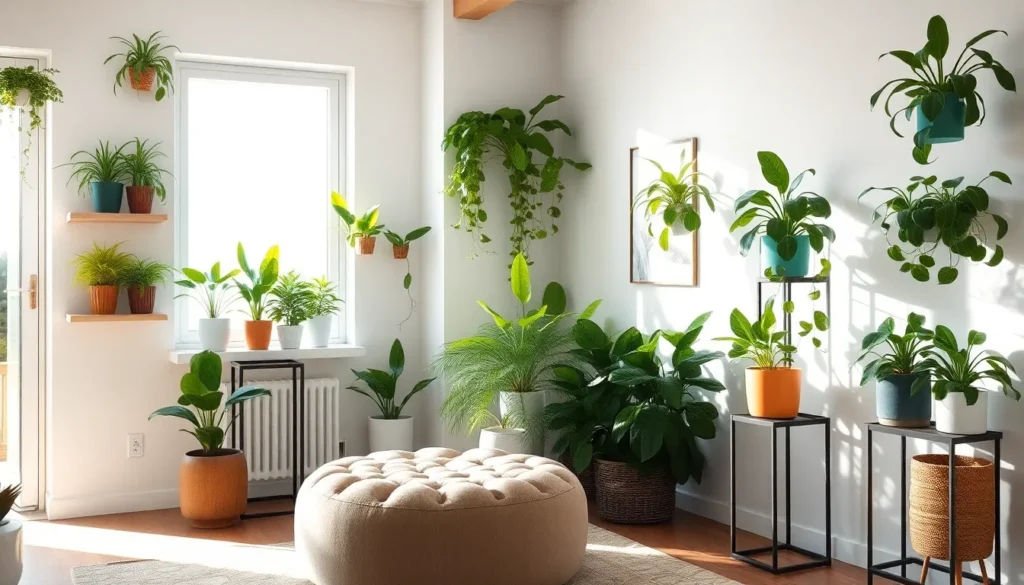Transforming a small living room into a green oasis doesn’t require sacrificing precious square footage. We’ve discovered that strategic plant placement can actually make compact spaces feel larger and more inviting while purifying your air naturally.
Small spaces present unique opportunities for creative plant styling that larger rooms simply can’t match. From vertical gardens that draw the eye upward to carefully chosen corner specimens that add life without clutter, we’ll show you how to maximize every inch of your living area.
Whether you’re working with a studio apartment or a cozy family room, the right plants can become your most versatile decor elements. We’ve tested countless combinations to bring you foolproof strategies that’ll transform your small living room into a thriving indoor garden sanctuary.
Choose Compact Plant Varieties That Maximize Visual Impact
Selecting the right plants for small living spaces means focusing on varieties that deliver maximum aesthetic value while maintaining a minimal footprint. We’ve identified three powerhouse plants that transform cramped quarters into stunning green retreats.
Snake Plants for Vertical Interest
Snake plants excel at drawing the eye upward, creating the illusion of higher ceilings in compact living rooms. Their striking vertical leaves reach heights of 2-4 feet while occupying just 6-8 inches of floor space. We recommend placing these architectural beauties in corner spots where their sword-like foliage adds dramatic height without overwhelming narrow walkways.
Varieties like Sansevieria trifasciata ‘Laurentii’ feature golden-yellow edges that catch light beautifully, making small rooms appear brighter and more spacious. Position these plants near windows where natural light enhances their variegated patterns. Their slow growth rate means they won’t quickly outgrow your carefully planned small space layout.
Pothos for Trailing Elegance
Pothos vines create cascading greenery that softens hard edges in small living areas without consuming precious floor real estate. These versatile climbers thrive on shelves, hanging planters, or tall furniture where their heart-shaped leaves can trail gracefully downward. We find that golden pothos varieties reflect light particularly well, helping to brighten darker corners.
Training pothos along walls or around doorframes adds organic curves to boxy small spaces. Their rapid growth provides quick visual impact, with vines extending 6-10 feet within a single growing season. Regular pruning keeps them perfectly sized for compact areas while providing cuttings for expanding your plant collection throughout your small living room.
ZZ Plants for Low-Light Corners
ZZ plants thrive in the challenging low-light conditions common in small living rooms with limited window access. Their glossy leaves reflect available light effectively, creating bright spots in dim corners without requiring direct sunlight. We appreciate how these plants maintain their compact 2-3 foot height while spreading just 1-2 feet wide, making them ideal for tight spaces.
Zamioculcas zamiifolia tolerates neglect better than most houseplants, perfect for busy lifestyles in small living spaces. Their thick stems store water efficiently, reducing watering frequency to every 2-3 weeks. Place ZZ plants near dark corners, behind furniture, or in narrow spaces between walls where other plants would struggle to survive.
Utilize Vertical Space With Wall-Mounted Plant Solutions
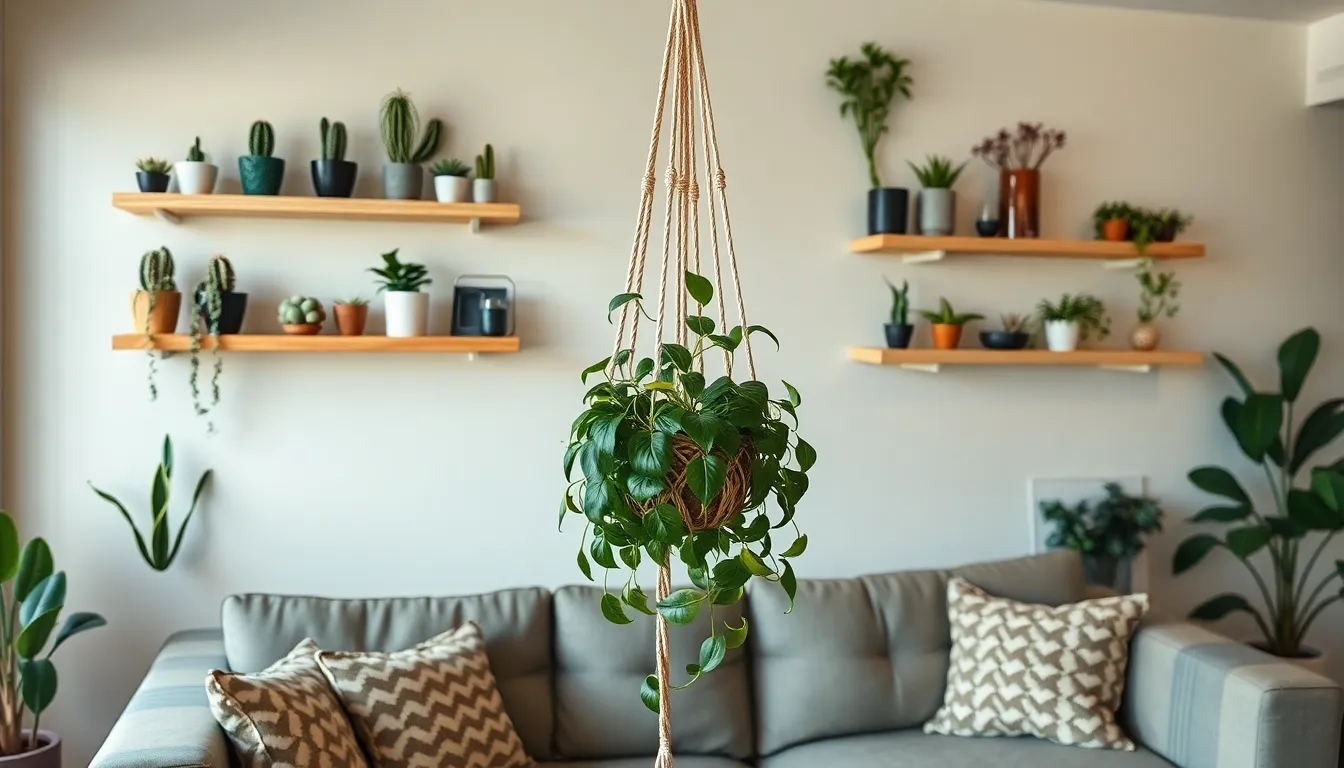
Building on our compact plant selection, we’ll explore how vertical mounting transforms walls into thriving gardens without sacrificing precious floor space.
Floating Shelves for Layered Displays
Floating shelves create stunning multi-level plant displays that draw the eye upward while maximizing our vertical real estate. We recommend installing these shelves near windows or bright corners to accommodate various light requirements—from sun-loving succulents to shade-tolerant varieties. Staggered shelf arrangements work particularly well for showcasing different pot sizes and plant heights.
Multiple shelves at varying heights allow us to create depth and visual interest throughout our living space. Small pots containing cacti, air plants, or trailing varieties can be strategically placed to form cascading green displays. This layered approach makes even the smallest walls feel lush and abundant.
Wall-Mounted Planters and Hanging Systems
Wall-mounted planters offer a sleek solution for incorporating greenery directly onto our vertical surfaces. These mounting systems eliminate the need for shelf space while creating clean, modern displays that complement contemporary decor. Ceiling-suspended hanging systems excel at showcasing trailing plants like pothos or string of pearls.
The downward flow of hanging plants creates a natural softening effect that balances hard architectural lines in our living rooms. We’ve found that these systems work exceptionally well for drawing attention upward, which enhances the perception of height and makes our spaces feel more expansive.
Macrame Plant Hangers for Bohemian Flair
Macrame plant hangers combine functionality with handcrafted appeal, bringing texture and bohemian style to our vertical displays. These versatile hangers can accommodate plants at various heights, creating ever-changing arrangements that highlight individual specimens. The woven designs add warmth and craftsmanship that contrasts beautifully with modern furnishings.
Hanging plants at different levels keeps them safely away from children and pets while maximizing our growing space. We particularly love how macrame hangers create focal points that celebrate both the plant and the artisanal hanger itself.
Create Multi-Level Displays Using Plant Stands and Risers
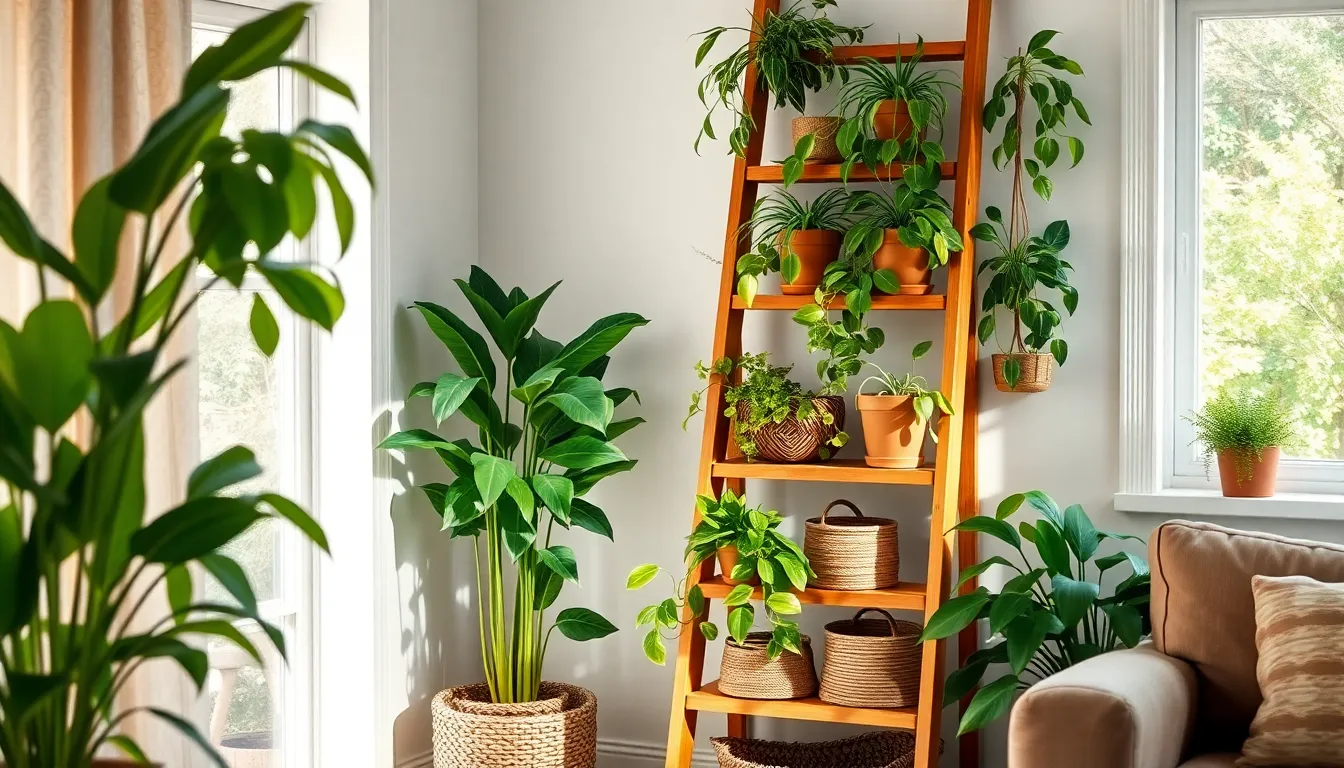
After mastering vertical wall mounting, we can expand our small space strategy by incorporating ground-based displays that maximize every inch of available floor space. Multi-level arrangements create stunning visual depth while accommodating more plants than traditional single-height displays.
Tiered Plant Stands for Corner Arrangements
Tiered plant stands transform neglected corners into vibrant focal points that draw the eye upward. We’ve found that these stands maximize vertical space while maintaining a minimal footprint, making them perfect for compact living rooms.
Arranging plants by size creates natural hierarchy on these stands. Tall specimens like corn plants or philodendrons anchor the display on lower tiers, while smaller varieties fill upper levels. This approach ensures each plant receives proper light exposure based on its exact needs.
Corner arrangements benefit from this tiered system because they organize greenery without cluttering walkways. We can display multiple plants in a single corner space that would otherwise accommodate just one floor plant. The vertical structure adds dimension to flat wall areas while creating a lush, garden-like atmosphere.
Ever-changing displays emerge when we group plants with varying textures and colors on different tiers. Smooth-leafed plants contrast beautifully with textured varieties, while different shades of green create visual interest without overwhelming small spaces.
Wooden Ladder Shelves for Rustic Appeal
Wooden ladder shelves bring natural texture and rustic charm to modern living spaces while serving as functional plant displays. These vertical structures use wall space efficiently and accommodate small to medium-sized plants across multiple levels.
Rustic containers enhance the organic aesthetic when paired with ladder shelves. Vintage crocks, weathered terracotta pots, and woven baskets complement the wood’s natural grain while adding personality to our plant arrangements.
Cascading plants create stunning hanging effects when placed on higher rungs. Pothos and string of pearls naturally drape downward, adding movement and softness to the structured ladder design. This technique maximizes visual impact while maintaining the shelf’s functionality.
Grouping plants with similar care requirements on ladder shelves simplifies maintenance routines. We can position sun-loving species on upper rungs near windows while shade-tolerant varieties thrive on lower levels with less direct light exposure.
Stackable Plant Risers for Flexible Arrangements
Stackable risers offer unmatched flexibility for adjusting plant heights on tables, shelves, and window ledges. These versatile tools help us create sculptural displays that transform ordinary surfaces into ever-changing plant galleries.
Succulents and cacti shine in riser arrangements because their compact size suits the elevated display format. We can create desert landscapes using various heights while ensuring each plant receives adequate light exposure without overcrowding.
Configuration changes become effortless with stackable systems. Seasonal plant rotations, new acquisitions, and growth patterns all accommodate easily when we can adjust riser heights and positions. This adaptability keeps displays fresh and prevents static arrangements.
Preventing overcrowding becomes manageable when risers separate plants at different levels. Each specimen gets proper attention and light access, promoting healthier growth while maintaining the organized appearance essential for small space success.
| Riser Type | Best Plants | Space Required | Flexibility Rating |
|---|---|---|---|
| Single-tier | Succulents, small herbs | 6-8 inches | High |
| Double-tier | Ferns, trailing plants | 10-12 inches | Medium |
| Triple-tier | Mixed varieties | 14-16 inches | Low |
Incorporate Hanging Plants to Draw the Eye Upward
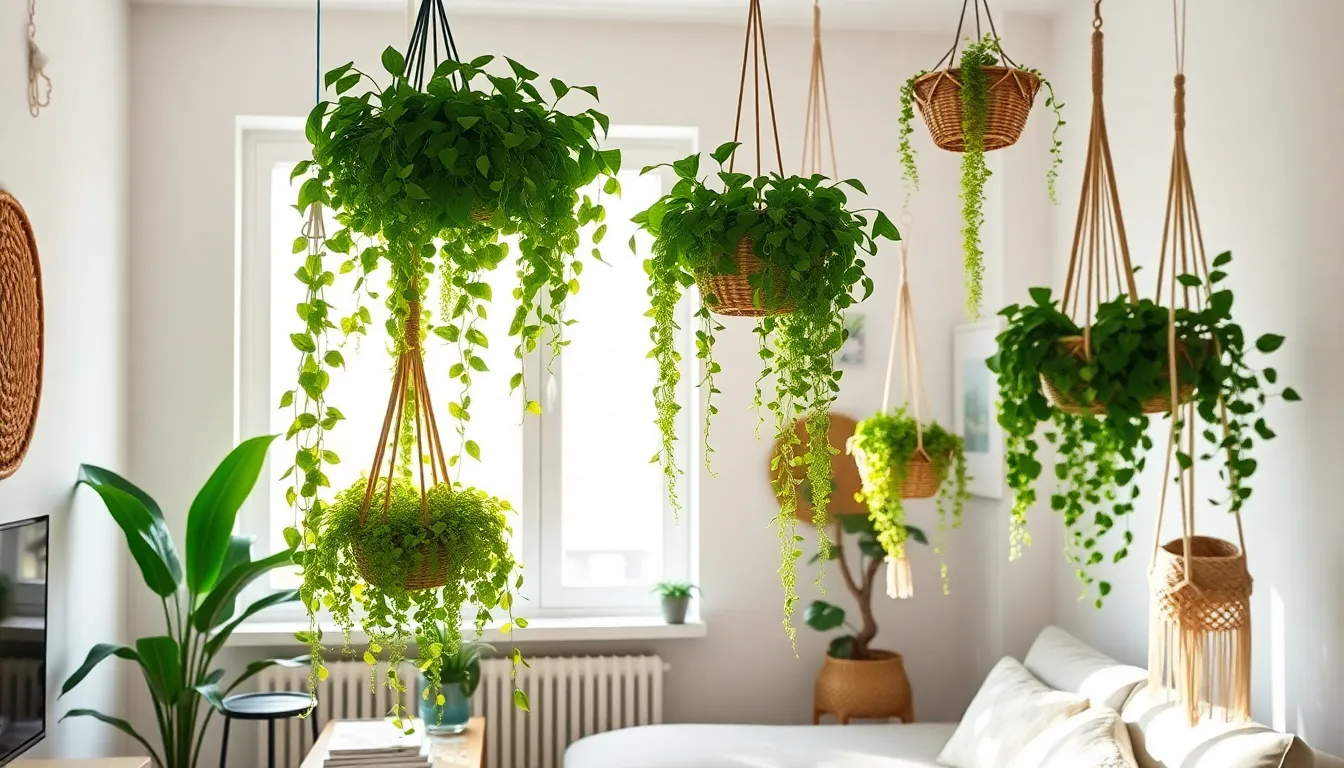
Building on our vertical mounting strategies, hanging plants take space optimization to the next level by utilizing overhead areas that typically remain empty. These suspended gardens create dramatic visual interest while keeping valuable floor space completely clear.
Ceiling-Mounted Hooks for Dramatic Drops
Installing ceiling hooks transforms your overhead space into a stunning display area for cascading greenery. We recommend using sturdy hooks that can support the weight of both planters and mature plants as they grow longer over time. Trailing varieties like pothos and String of Pearls work exceptionally well because their vines create soft, flowing movement that draws attention upward. The longer these plants grow, the more impactful your display becomes, turning plain ceilings into living art installations.
Plant selection matters significantly for ceiling displays since you’ll want species that thrive without frequent handling. Pothos adapts to various light conditions and grows quickly, while String of Pearls adds unique texture with its distinctive bead-like foliage. Both varieties require minimal maintenance once established in their suspended positions.
Tension Rod Systems for Rental-Friendly Options
Renters can achieve the same dramatic hanging effect without drilling permanent holes using tension rod systems. We’ve found that adjustable rods work perfectly between walls or in doorways, supporting lightweight planters without any damage to your living space. This approach offers incredible flexibility since you can easily relocate your hanging garden when rearranging furniture or moving to a new home.
Lightweight containers become essential when using tension rods since the system has weight limitations. Macrame hangers paired with ceramic or lightweight resin planters create beautiful displays that won’t strain the rod mechanism. You can also create mini shelves along the tension rod to hold small succulents or air plants for varied heights and textures.
Corner Hanging Baskets for Unused Spaces
Corners represent some of the most underutilized areas in small living rooms, making them perfect candidates for hanging plant displays. We position corner hanging baskets to transform these forgotten spaces into charming focal points that don’t interfere with traffic flow. Tall, narrow plants or cascading species work best because they emphasize the vertical lines of the corner while adding natural softness.
Selecting the right basket style enhances both function and aesthetics in corner installations. Woven baskets add natural texture that complements most decor styles, while modern geometric planters create contemporary appeal. The key lies in choosing plants that grow appropriately for the corner’s light conditions, ensuring your hanging garden thrives rather than simply survives in its suspended position.
Select Space-Saving Planters That Serve Dual Purposes
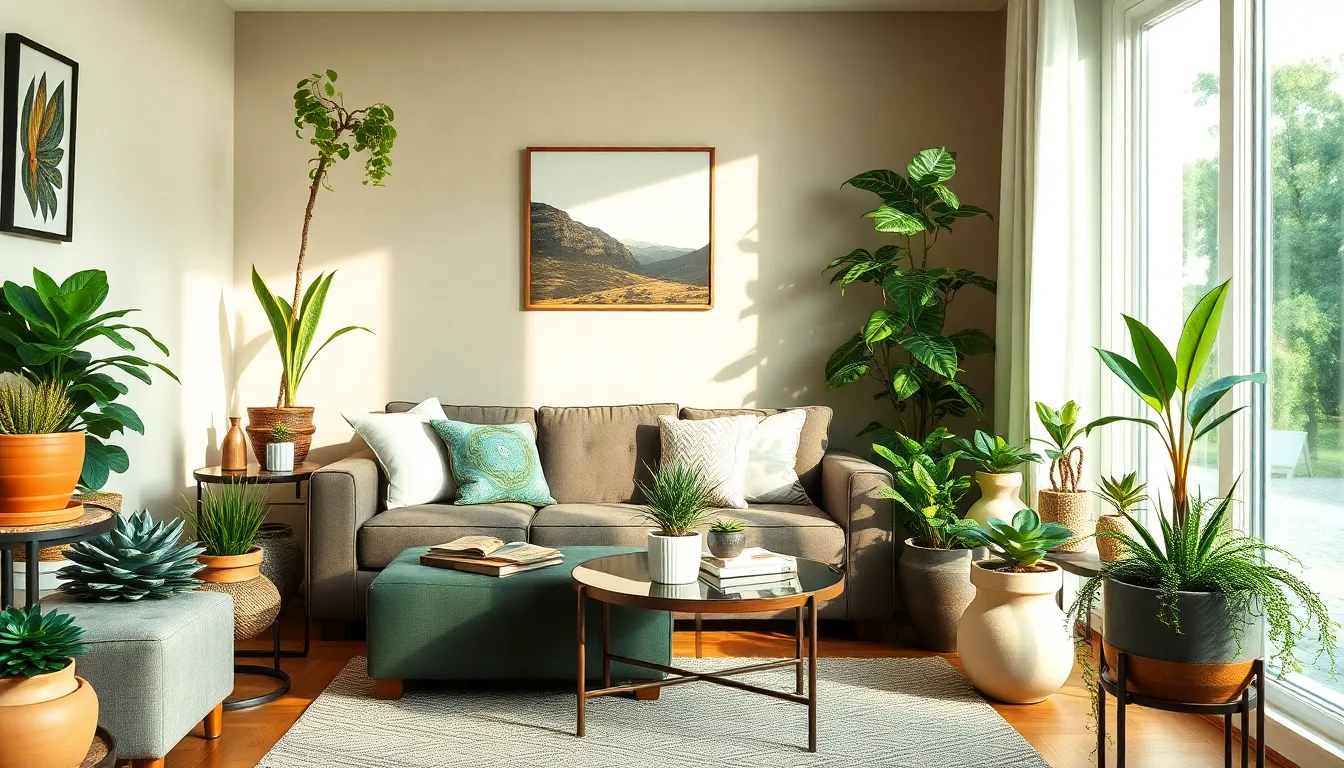
We can transform our small living rooms into lush sanctuaries by choosing planters that work double duty. Smart dual purpose containers eliminate the need to choose between functional furniture and beautiful greenery.
Ottoman Planters for Extra Seating
Ottoman planters combine comfortable seating with integrated growing space, making them perfect for compact living areas. These multifunctional pieces allow us to incorporate plants without sacrificing valuable floor real estate or seating capacity. We can position these versatile ottomans near coffee tables or along walls where guests often need extra perching spots.
Storage compartments in many ottoman planters provide additional organization benefits beyond their primary dual function. Waterproof liners protect the internal structure while allowing proper drainage for healthy plant growth. Round ottoman planters work exceptionally well in conversation areas, while rectangular versions fit seamlessly against walls or under windows.
Side Table Planters for Functional Decor
Side table planters create stunning focal points on surfaces we’re already using throughout our living spaces. Grouping several small containers together on existing side tables maximizes our greenery impact without requiring additional floor space allocation. We can arrange different sized planters in odd numbered clusters for the most visually appealing compositions.
Succulents and cacti thrive on side tables positioned in bright room locations, while shade loving ferns flourish in darker corner spots. Terracotta containers blend beautifully with rustic decor styles, whereas sleek ceramic planters complement modern living room aesthetics. Trailing plants like small pothos varieties add elegant cascading elements to side table arrangements.
Window Sill Planters for Natural Light
Window sill planters leverage the abundant natural light streaming through our windows while utilizing space that often goes unused. This strategic placement works especially well in rooms where floor space comes at a premium. We can line entire window ledges with small containers to create impressive green displays that don’t intrude into our walking areas.
Small herbs like basil and mint thrive on sunny window sills, providing fresh ingredients alongside decorative appeal. Vintage crocks and woven baskets add charming character while serving as practical planter containers. Long rectangular planters span wider window sills efficiently, accommodating multiple plant varieties in organized rows that create cohesive visual impact.
Group Plants by Size and Shape for Maximum Visual Impact
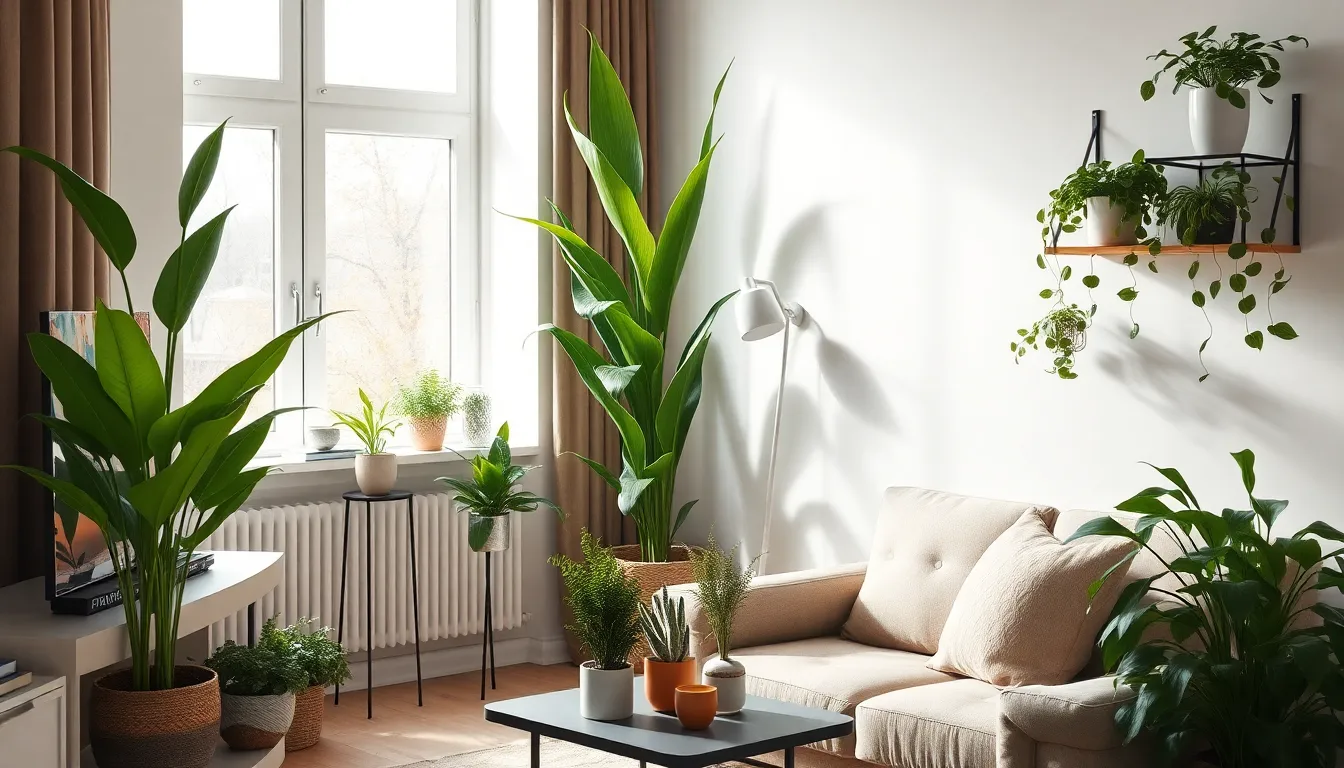
Organizing plants by their size and shape transforms cluttered spaces into intentional displays that draw the eye naturally. Strategic grouping creates focal points while preventing your small living room from feeling overwhelmed by greenery.
The Rule of Three for Balanced Arrangements
Three plants create the perfect balance between visual interest and spatial harmony. Odd numbered groupings avoid the formal symmetry that can make small spaces feel stiff and unnatural. We recommend combining one tall plant with two smaller companions to establish natural hierarchy.
Triangular arrangements work exceptionally well on console tables and corner spaces. Position your tallest plant at the back, then place medium and small plants to form an invisible triangle. This technique draws the eye through the grouping while maintaining proportional balance.
Varying the container heights within your trio adds another layer of visual depth. Use plant stands or decorative risers to create staggered levels, allowing each plant to shine individually while contributing to the overall composition.
Mixing Heights for Ever-changing Compositions
Vertical layering maximizes your growing space without claiming precious floor area. Combine tall floor plants like corn plants or philodendrons with medium sized plants on stands and trailing varieties on shelves. This approach creates the urban jungle feel we’re after in compact settings.
Hanging planters and wall mounted shelves use often overlooked vertical real estate. These answers allow your greenery to flourish above eye level, creating the illusion of height while keeping walkways clear. Trailing plants like pothos or string of pearls work beautifully in elevated positions.
Floor to ceiling plant displays create dramatic focal walls in small living rooms. Layer plants at different heights using a combination of floor stands, floating shelves, and ceiling hooks. This technique makes your room feel larger by drawing the eye upward through multiple levels of greenery.
Color Coordination for Cohesive Design
Matching container colors with your room’s palette creates a curated, intentional look. Choose planters in neutral tones like terracotta, white ceramics, or natural wood that complement your existing decor. Containers become part of the design rather than competing with it.
Foliage colors should enhance your room’s color scheme without overwhelming the space. Mix various shades of green with occasional pops of color from plants like anthuriums or colorful pothos varieties. This approach adds visual interest while maintaining overall harmony.
Texture coordination between plants and containers adds sophisticated depth to your arrangements. Pair smooth ceramic pots with structured plants like snake plants, or choose woven baskets for softer, flowing varieties like ferns. These thoughtful combinations create cohesive groupings that feel professionally designed.
Position Plants Strategically to Enhance Natural Light
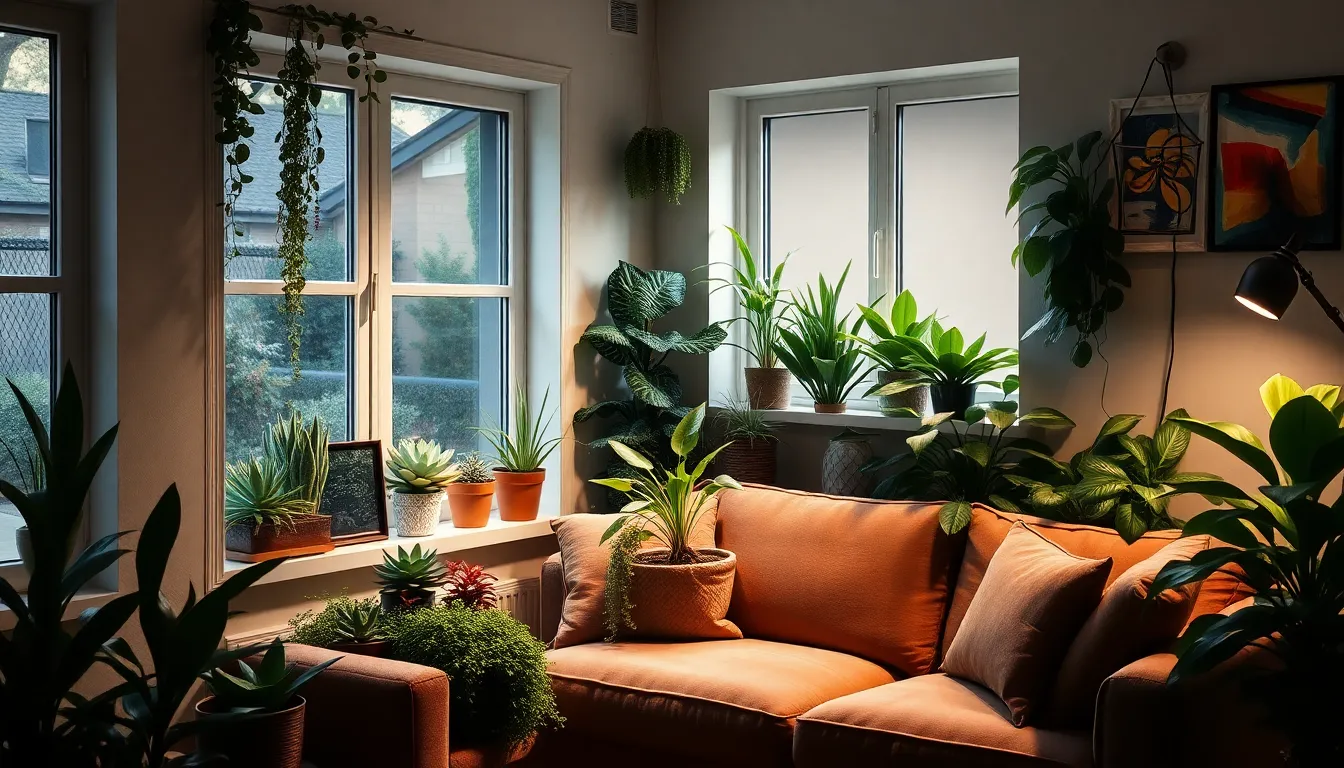
Now that we’ve explored grouping techniques and space-saving answers, let’s focus on how light positioning can dramatically transform your small living room’s plant display while maximizing each plant’s health and visual impact.
South-Facing Windows for Sun-Loving Species
Capitalize on your brightest spots by placing sun-loving plants near south-facing windows where they’ll receive maximum sunlight throughout the day. Succulents like jade plants and echeveria thrive in these bright conditions, creating stunning focal points without requiring much floor space. Position aloe vera and anthurium plants on window sills or nearby plant stands to take advantage of the direct sunlight these species crave.
Transform your south-facing area into a desert-inspired display by grouping different succulent varieties in matching containers. This creates visual cohesion while ensuring each plant receives the bright light it needs to maintain its compact, colorful appearance. Arrange taller specimens like snake plants or rubber trees slightly back from the window to prevent leaf burn while still providing them with abundant indirect light.
North-Facing Areas for Shade-Tolerant Plants
Embrace your dimmer corners by selecting plants that flourish in low-light conditions rather than fighting against your room’s natural lighting patterns. Snake plants, pothos, and ZZ plants excel in north-facing areas, bringing lush greenery to spaces that might otherwise feel dark or neglected. Create depth in these areas by placing peace lilies and ferns at varying heights using plant stands or hanging planters.
Maximize these cooler spots by grouping shade-tolerant species together to form a verdant corner display. Boston ferns and Chinese evergreens create beautiful textural contrasts when positioned at different levels, while their similar light requirements make maintenance straightforward. Use these naturally dim areas to your advantage by creating cozy reading nooks surrounded by low-light loving plants that won’t compete for your room’s precious bright spots.
Artificial Light Answers for Dark Corners
Install full-spectrum grow lights in corners that lack sufficient natural light to expand your plant placement options throughout your small living room. LED plant lamps can be strategically positioned above plant groupings to supplement natural light without consuming valuable floor space. Position these lights 12-18 inches above your plants to provide adequate coverage while maintaining the aesthetic appeal of your display.
Combine artificial lighting with reflective surfaces like light-colored walls or strategically placed mirrors to amplify both natural and artificial light throughout your space. This technique allows you to grow light-loving plants in previously unusable dark corners while creating the illusion of a brighter, more spacious room. Choose adjustable grow light fixtures that can be moved or repositioned as your plant collection evolves, ensuring flexibility in your small space design.
Maintain Your Small Space Plant Collection Efficiently
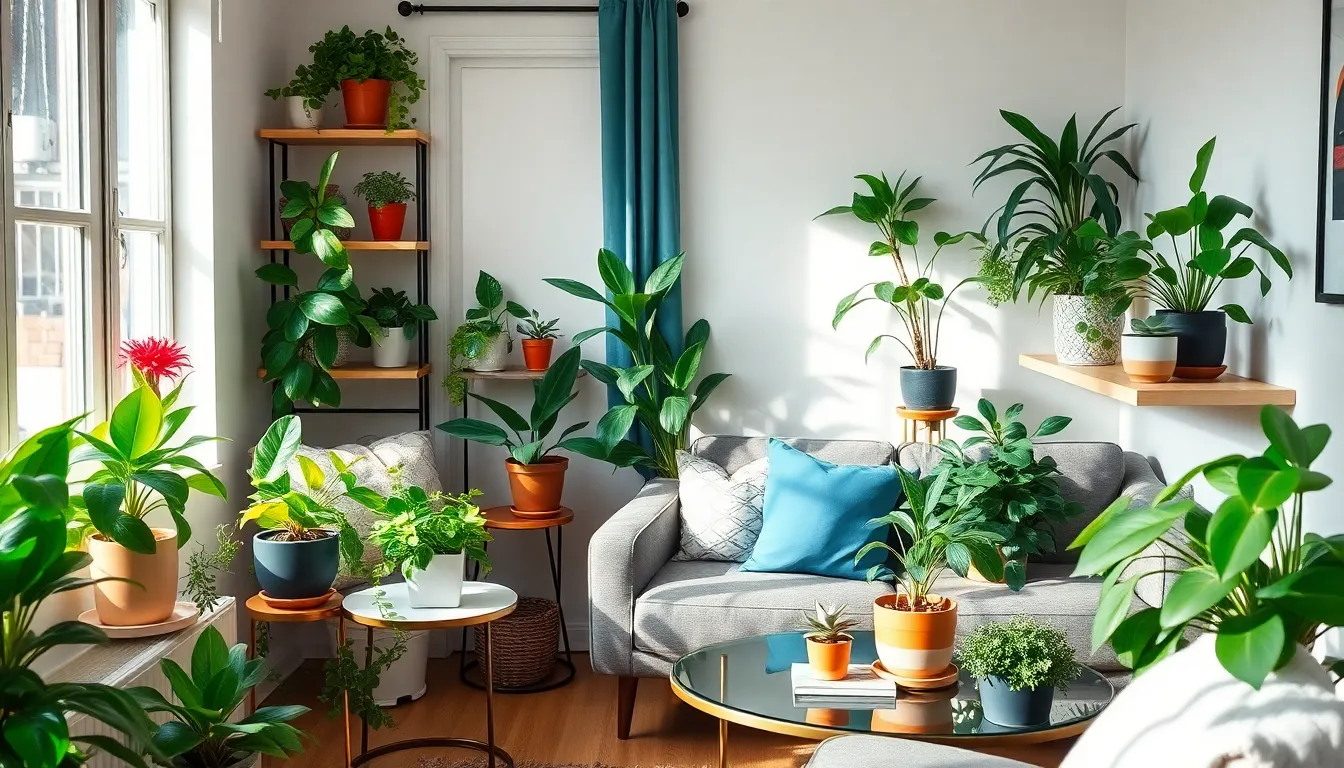
Smart maintenance strategies keep our compact plant displays thriving while minimizing effort and space requirements. Efficient care routines ensure every square inch of our living room serves a purpose.
Watering Schedules for Compact Arrangements
Customized watering keeps small space plants healthy without overwhelming limited soil volumes. Succulents and cacti thrive with infrequent watering sessions, requiring completely dry soil between applications. Tropical plants like pothos or peace lilies need consistent moisture but shouldn’t sit in standing water.
Monitor each plant’s exact needs based on room conditions. Light levels and humidity directly affect watering frequency in compact arrangements. Plants near windows typically need more water than those in darker corners.
Use drainage holes to prevent root rot in small containers. Check topsoil moisture before watering to avoid overwatering issues common in limited soil volumes. Small pots dry out faster than large ones, requiring more frequent attention.
Pruning Techniques for Size Control
Regular trimming maintains manageable plant sizes in confined spaces. Remove leggy or overgrown stems to encourage bushier, more compact growth patterns. Yellow or dead leaves should be eliminated immediately to keep displays looking fresh.
Pinch back trailing plants to promote dense foliage. Pothos and philodendron vines respond well to regular pinching, preventing sprawling growth that overwhelms small areas. Strategic pruning creates fuller, more attractive plant forms.
Improve airflow through selective pruning cuts. Better air circulation reduces pest problems and disease risks in tight spaces. Clean cuts with sharp tools prevent plant stress and promote healthy regrowth.
Rotating Plants for Even Growth
Turn plants periodically to ensure balanced light exposure from all angles. Small spaces often provide light from one primary direction, causing plants to lean toward the source. Quarter turns every week maintain symmetrical growth patterns.
Use rotation time for thorough plant health inspections. Check for pest issues, disease signs, or watering needs while repositioning plants. Early detection prevents problems from spreading throughout compact collections.
Optimize growing conditions through strategic placement changes. Move plants between locations based on seasonal light changes and individual growth responses. Rotation maximizes each plant’s potential in limited space arrangements.
Conclusion
We’ve shown you that small living rooms don’t have to mean sacrificing your green thumb dreams. With the right plant choices vertical displays and strategic placement you can create a lush indoor sanctuary that feels both spacious and inviting.
The key lies in thinking creatively about every available surface from walls to windowsills. By combining smart maintenance practices with thoughtful design principles you’ll maintain a thriving plant collection without overwhelming your compact space.
Your small living room has incredible potential to become the green oasis you’ve always wanted. Start with one or two plants and gradually build your collection using our proven strategies for maximum impact.
Frequently Asked Questions
What are the best plants for small living rooms?
Snake Plants, Pothos, and ZZ Plants are ideal for small spaces. These compact varieties offer maximum visual impact without overwhelming the room. Snake Plants provide vertical interest, Pothos create cascading effects, and ZZ Plants thrive in low-light conditions while maintaining their sleek appearance.
How can I create a vertical garden in my small living room?
Transform walls into thriving gardens using floating shelves, wall-mounted planters, and macrame hangers. These vertical mounting techniques maximize growing space while creating the illusion of height. Position plants at different levels to create visual depth and make your room feel larger.
What are space-saving planters that serve multiple purposes?
Ottoman planters combine seating with growing space, while side table planters create focal points without requiring additional floor space. Window sill planters utilize natural light for herbs and small plants. These dual-purpose solutions maximize functionality while maintaining your room’s aesthetic appeal.
How do I arrange plants to make my small room look bigger?
Use the “Rule of Three” with triangular arrangements and varying container heights. Group plants by size and shape, creating intentional displays that draw the eye upward. Multi-level displays using plant stands and risers add dimension while maintaining organized, visually appealing arrangements.
What lighting considerations are important for small space plant displays?
Position sun-loving plants like succulents near south-facing windows and shade-tolerant plants like snake plants in north-facing areas. Use full-spectrum grow lights for darker spaces and combine with reflective surfaces to create a brighter, more spacious atmosphere while optimizing plant health.
How do I maintain plants in small spaces efficiently?
Develop customized watering schedules based on each plant’s needs while monitoring light and humidity levels. Use regular pruning to maintain manageable sizes and promote bushier growth. Rotate plants periodically to ensure even growth and maximize their potential in compact arrangements.
How can I coordinate plant colors with my room’s design?
Match container colors with your room’s existing palette and mix different foliage colors for visual interest. Coordinate textures between plants and containers to create sophisticated, professionally designed groupings that enhance rather than clash with your living room’s overall aesthetic.

